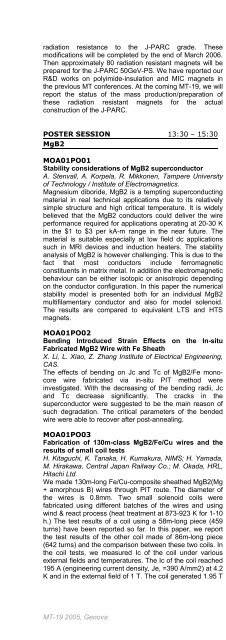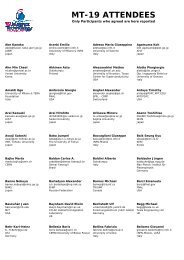Click here to download the abstract booklet in pdf format - MT19 - Infn
Click here to download the abstract booklet in pdf format - MT19 - Infn
Click here to download the abstract booklet in pdf format - MT19 - Infn
Create successful ePaper yourself
Turn your PDF publications into a flip-book with our unique Google optimized e-Paper software.
adiation resistance <strong>to</strong> <strong>the</strong> J-PARC grade. These<br />
modifications will be completed by <strong>the</strong> end of March 2006.<br />
Then approximately 80 radiation resistant magnets will be<br />
prepared for <strong>the</strong> J-PARC 50GeV-PS. We have reported our<br />
R&D works on polyimide-<strong>in</strong>sulation and MIC magnets <strong>in</strong><br />
<strong>the</strong> previous MT conferences. At <strong>the</strong> com<strong>in</strong>g MT-19, we will<br />
report <strong>the</strong> status of <strong>the</strong> mass production/preparation of<br />
<strong>the</strong>se radiation resistant magnets for <strong>the</strong> actual<br />
construction of <strong>the</strong> J-PARC.<br />
POSTER SESSION 13:30 – 15:30<br />
MgB2<br />
MOA01PO01<br />
Stability considerations of MgB2 superconduc<strong>to</strong>r<br />
A. Stenvall, A. Korpela, R. Mikkonen, Tampere University<br />
of Technology / Institute of Electromagnetics.<br />
Magnesium diboride, MgB2 is a tempt<strong>in</strong>g superconduct<strong>in</strong>g<br />
material <strong>in</strong> real technical applications due <strong>to</strong> its relatively<br />
simple structure and high critical temperature. It is widely<br />
believed that <strong>the</strong> MgB2 conduc<strong>to</strong>rs could deliver <strong>the</strong> wire<br />
performance required for applications operat<strong>in</strong>g at 20-30 K<br />
<strong>in</strong> <strong>the</strong> $1 <strong>to</strong> $3 per kA-m range <strong>in</strong> <strong>the</strong> near future. The<br />
material is suitable especially at low field dc applications<br />
such <strong>in</strong> MRI devices and <strong>in</strong>duction heaters. The stability<br />
analysis of MgB2 is however challeng<strong>in</strong>g. This is due <strong>to</strong> <strong>the</strong><br />
fact that most conduc<strong>to</strong>rs <strong>in</strong>clude ferromagnetic<br />
constituents <strong>in</strong> matrix metal. In addition <strong>the</strong> electromagnetic<br />
behaviour can be ei<strong>the</strong>r iso<strong>to</strong>pic or anisotropic depend<strong>in</strong>g<br />
on <strong>the</strong> conduc<strong>to</strong>r configuration. In this paper <strong>the</strong> numerical<br />
stability model is presented both for an <strong>in</strong>dividual MgB2<br />
multifilamentary conduc<strong>to</strong>r and also for model solenoid.<br />
The results are compared <strong>to</strong> equivalent LTS and HTS<br />
magnets.<br />
MOA01PO02<br />
Bend<strong>in</strong>g Introduced Stra<strong>in</strong> Effects on <strong>the</strong> In-situ<br />
Fabricated MgB2 Wire with Fe Sheath<br />
X. Li, L. Xiao, Z. Zhang Institute of Electrical Eng<strong>in</strong>eer<strong>in</strong>g,<br />
CAS.<br />
The effects of bend<strong>in</strong>g on Jc and Tc of MgB2/Fe monocore<br />
wire fabricated via <strong>in</strong>-situ PIT method were<br />
<strong>in</strong>vestigated. With <strong>the</strong> decreas<strong>in</strong>g of <strong>the</strong> bend<strong>in</strong>g radii, Jc<br />
and Tc decrease significantly. The cracks <strong>in</strong> <strong>the</strong><br />
superconduc<strong>to</strong>r were suggested <strong>to</strong> be <strong>the</strong> ma<strong>in</strong> reason of<br />
such degradation. The critical parameters of <strong>the</strong> bended<br />
wire were able <strong>to</strong> recover after post-anneal<strong>in</strong>g.<br />
MOA01PO03<br />
Fabrication of 130m-class MgB2/Fe/Cu wires and <strong>the</strong><br />
results of small coil tests<br />
H. Kitaguchi, K. Tanaka, H. Kumakura, NIMS; H. Yamada,<br />
M. Hirakawa, Central Japan Railway Co.; M. Okada, HRL,<br />
Hitachi Ltd.<br />
We made 130m-long Fe/Cu-composite shea<strong>the</strong>d MgB2(Mg<br />
+ amorphous B) wires through PIT route. The diameter of<br />
<strong>the</strong> wires is 0.8mm. Two small solenoid coils were<br />
fabricated us<strong>in</strong>g different batches of <strong>the</strong> wires and us<strong>in</strong>g<br />
w<strong>in</strong>d & react process (heat treatment at 873-923 K for 1-10<br />
h.) The test results of a coil us<strong>in</strong>g a 58m-long piece (459<br />
turns) have been reported so far. In this paper, we report<br />
<strong>the</strong> test results of <strong>the</strong> o<strong>the</strong>r coil made of 86m-long piece<br />
(642 turns) and <strong>the</strong> comparison between <strong>the</strong>se two coils. In<br />
<strong>the</strong> coil tests, we measured Ic of <strong>the</strong> coil under various<br />
external fields and temperatures. The Ic of <strong>the</strong> coil reached<br />
195 A (eng<strong>in</strong>eer<strong>in</strong>g current density, Je, =390 A/mm2) at 4.2<br />
K and <strong>in</strong> <strong>the</strong> external field of 1 T. The coil generated 1.95 T<br />
(<strong>the</strong> center magnetic field, Bo), thus <strong>the</strong> <strong>to</strong>tal field reached<br />
2.95 T. Je exceeded 100 A/mm2 <strong>in</strong> <strong>the</strong> external fields<br />
below 3.5 T, 2.5 T, and 1.5 T at 15 K, 20 K, and 25 K,<br />
respectively. These performances of 86m-coil are similar<br />
very much <strong>to</strong> those of 58m-coil. This <strong>in</strong>dicates that <strong>the</strong><br />
fabrication process of 130m-long wire and <strong>the</strong> heat<br />
treatment process are highly reproducible.<br />
MOA01PO04<br />
Self-field Loss <strong>in</strong> AC Transport Current for Ni-shea<strong>the</strong>d<br />
MgB2 Superconduct<strong>in</strong>g Tapes<br />
S. Murase, M. I<strong>in</strong>o, S. Kim, N. Nana<strong>to</strong>, Okayama<br />
University; Y. Yamada, K. Tachikawa, Tokai University.<br />
AC transport current loss (self field loss) of exsituprocessed<br />
MgB2 superconduct<strong>in</strong>g tapes with Ni sheath<br />
was measured under different conditions of transport<br />
current value, transport current frequency, and<br />
temperature. Experimental results were compared with<br />
Norris’ <strong>the</strong>oretical curve, which were larger than <strong>the</strong><br />
<strong>the</strong>oretical one and decreased with <strong>in</strong>creas<strong>in</strong>g frequency.<br />
Fur<strong>the</strong>rmore, loss – normalized transport current (transport<br />
current normalized by critical current) curves varied with<br />
temperature and <strong>the</strong> loss at 9 K was larger than that at 14<br />
K. The frequency dependency of <strong>the</strong> loss is considered <strong>to</strong><br />
be due <strong>to</strong> <strong>the</strong> sk<strong>in</strong> effect. Although one of <strong>the</strong> loss orig<strong>in</strong>s is<br />
<strong>the</strong> hysteresis of ferromagnetic nickel-sheath, <strong>the</strong><br />
hysteresis loss of Ni was <strong>to</strong> be negligibly small based on<br />
<strong>the</strong> estimation and measurement for loss of Ni. Ma<strong>in</strong><br />
contributions <strong>to</strong> large loss are clarified by <strong>in</strong>troduc<strong>in</strong>g a<br />
model of three concentric layers of MgB2 core <strong>in</strong> <strong>the</strong> wire<br />
caused by <strong>the</strong> <strong>in</strong>homogeneity of critical current density and<br />
critical temperature. The measured curves and<br />
characteristics of loss – normalized transport current<br />
accorded with <strong>the</strong> calculated curves us<strong>in</strong>g above<br />
mentioned three-layered model.<br />
MOA01PO05<br />
Superconduct<strong>in</strong>g properties of MgB2 tapes fabricated<br />
with different alloys as sheath materials<br />
V. Bracc<strong>in</strong>i, C. Fanciulli, M. Tropeano, M. Vignolo, A.<br />
Tum<strong>in</strong>o, A. Malagoli, C. Bern<strong>in</strong>i, G. Grasso, A.S. Siri,<br />
INFM-LAMIA.<br />
At present, MgB2 appears suitable for niche applications at<br />
low and <strong>in</strong>termediate magnetic fields, and it has been<br />
shown <strong>to</strong> possess magnetic field capabilities that can be<br />
improved so as <strong>to</strong> overcome those of <strong>the</strong> best low Tc<br />
superconduc<strong>to</strong>rs at 4.2K. At <strong>the</strong> same time, viable wire and<br />
tape technologies have been developed lead<strong>in</strong>g <strong>to</strong> samples<br />
with good superconduct<strong>in</strong>g properties over long lengths.<br />
We studied <strong>the</strong> <strong>in</strong>fluence of <strong>the</strong> de<strong>format</strong>ion process, <strong>the</strong><br />
sheath material and <strong>the</strong> precursor powders on <strong>the</strong><br />
superconduct<strong>in</strong>g properties of ex-situ powder-<strong>in</strong>-tube<br />
processed MgB2 tapes. We used magnetic (Ni), slightly<br />
magnetic (Ni-W alloys) or non-magnetic (Ni-Cr alloys)<br />
sheaths. We used a commercially available Ni80-Cr20<br />
alloy and we produced Ni-Cr and Ni-W alloys with different<br />
Cr or W percentages. We correlated <strong>the</strong>ir structural and<br />
physical properties with <strong>the</strong> different chemical<br />
compositions. Be<strong>in</strong>g <strong>the</strong>se Ni alloys much harder than <strong>the</strong><br />
Ni, <strong>the</strong>ir use <strong>in</strong>duces a higher degree of stress improv<strong>in</strong>g<br />
properties such as <strong>the</strong> critical current density and <strong>the</strong><br />
irreversibility field. On <strong>the</strong> o<strong>the</strong>r side, it is very hard <strong>to</strong> be<br />
cold-worked and cracks may occur <strong>in</strong> <strong>the</strong> phase,<br />
deteriorat<strong>in</strong>g <strong>the</strong> properties of <strong>the</strong> superconduc<strong>to</strong>r. We<br />
studied <strong>the</strong> <strong>in</strong>fluence of <strong>the</strong> pre-reacted MgB2 powders on<br />
<strong>the</strong> f<strong>in</strong>al properties of <strong>the</strong> tapes. We used powders with<br />
different granulometry, and doped <strong>in</strong> a different way, <strong>in</strong><br />
order <strong>to</strong> <strong>in</strong>crease <strong>the</strong> critical current density and improve<br />
<strong>the</strong> magnetic field capability of such tapes.<br />
MT-19 2005, Genova 24



